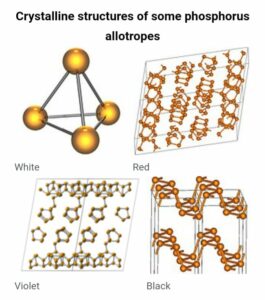In this article we are going to study facts about phosphorus valence electrons and the compounds formed by them.
Phosphorus belongs to the 15 and 3rd period, basically it is a p-block element. Phosphorus valence electrons are equal to five. So in the further sections we will be discussing various phosphorus compounds and related facts.
Phosphorus in its elemental form is seen to exist in two forms namely white phosphorus and red phosphorus. Red phosphorus seems to be rare on earth due to its high reactivity. Many allotropes of phosphorus are seen to exist some of them include red, white, black, violet, etc. The white phosphorus is sometimes also referred to as yellow phosphorus because on exposure to light the white phosphorus turns into yellow color.
P4 (Phosphorus)
White phosphorus
White phosphorus is also called as devil’s element, the reason being it has possibility to glow (green) in the dark.
It is very unstable hence its reactivity is quite high and is a volatile compound. As we can see in the structure there are 4 atoms of phosphorus that are arranged in a tetrahedral manner. It’s odor is similar to that of garlic which is very unpleasant. Its preferred to be stored under water due to its high reactivity.

Image credit: Wikipedia
Red phosphorus
It’s structure is observed to be polymeric.
It is produced or formed when white phosphorus is heated at a temperature of 250 degrees Celsius or sometimes when white phosphorus is exposed to light (sunlight). We can also say that red phosphorus is an intermediate (phase) in between the white phosphorus and red phosphorus. The freshly prepared red phosphorus is seen to be very reactive and can ignite at a temperature of 300 degrees Celsius.

Violet phosphorus
This compound is produced is formed when the red phosphorus is heated at a temperature of 550 degrees Celsius. It is also known as Hittorf’s phosphorus and alpha metallic phosphorus. This compound is known for its properties like electronic and optoelectronic properties.
Black phosphorus
Among all the phosphorus compounds Black phosphorus is seen to be less reactive. It’s synonym is beta metallic phosphorus. In structure it is similar to graphite. It is produced when white phosphorus is heated at very high temperature and pressure.

Chemiluminescence
In dark phosphorus (usually white phosphorus) glows in dark and this phenomenon is known as chemiluminescence.

P4 lewis dot structure
Talking about the bonding in p4 molecule as we can see that there are 4 phosphorus atoms in the structure.
The valence electrons in phosphorus are 5. Since 4 phosphorus atoms are present the total phosphorus valence electrons will be 5×4=20 electrons. What happens is the phosphorus atoms are placed in tetrahedral manner and then they are linked such that the valency of each of the phosphorus atom is satisfied.
Phosphorus valence electrons configuration
The valence electrons in phosphorus are 5. The valence electrons configuration is 3s2 3p3.
Phosphorus Valence Electrons charge
We know that there are 5 valence electrons in phosphorus and it is a non metal. It is seen to have more affinity towards electrons hence it will prefer gaining electrons rather then losing electrons.
So it needs three more electrons to complete its octet, therefore it will gain three electrons and satisfy its valency. Hence the charge on phosphorus valence electrons is -3.
Phosphorus valence electrons and valency
The phosphorus valence electrons are 5. What we understand is by the term valency is its capacity to gain or lose electrons in order to acquire a complete octet. So the valency of phosphorus is equal to 3.
This is Sania Jakati from Goa. I am an aspiring chemist pursuing my post graduation in organic chemistry. I believe education is the key element that moulds you into a great human being both mentally and physically. I’m glad to be a member of scintillating branch of chemistry and will try my best to contribute whatever I can from my side and Lambdageeks is the best platform where I can share as well as gain knowledge at the same time.